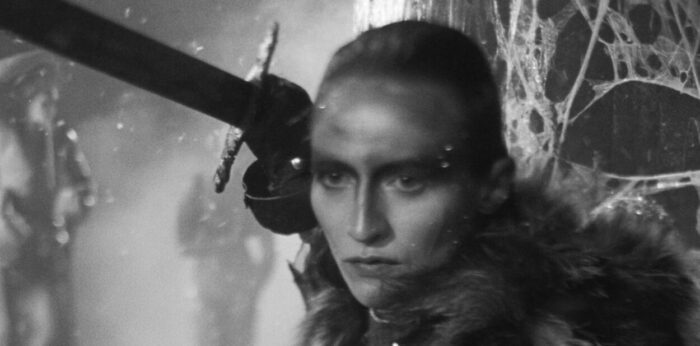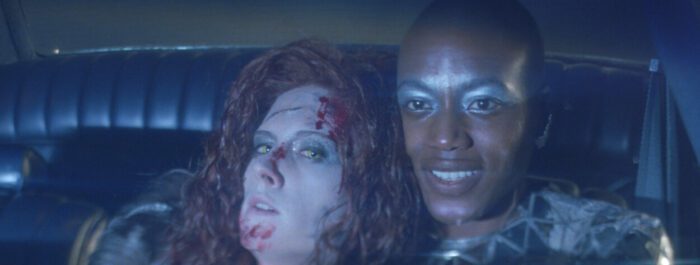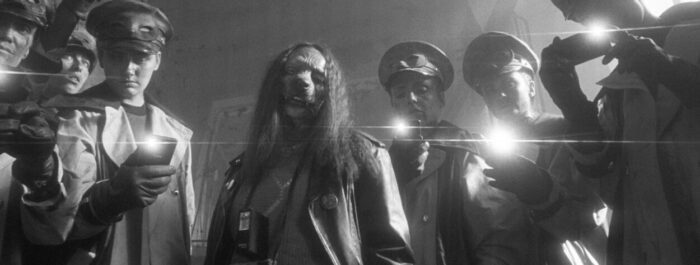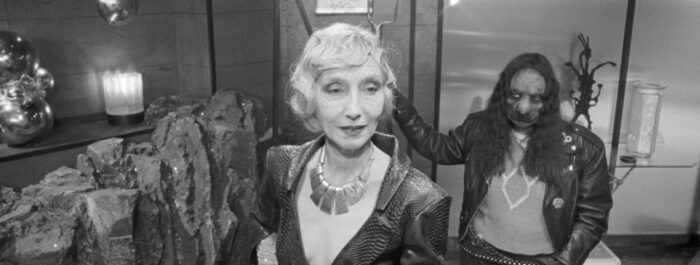She Is Conann is not your father’s Conan. If you recall the 1982 Conan the Barbarian sword-and-sorcery actioner featuring a famous bodybuilder and future governor, directed by John Milius (or its 1984 sequel Conan the Destroyer), you’ll channel that rendition’s redlining testosterone and performative virility as its oiled-up superhero muscled his way through one conquest after another. French surrealist auteur Bertrand Mandico’s version of the legend is a gender-swapped lesbian lovefest that wants nothing to do with the Schwarzeneggers of yore and so dispenses with its male lead, with all men in fact altogether, in a poetic journey over a six different decades, each with its own unique incarnation.
Intrigued? Mandico’s films never lack for surprise nor shock. His first feature film in 2017, The Wild Boys (Les Garçons Sauvages), won the prestigious Prix Louis Delluc and was named the top film of 2018 by Cahiers du cinéma. His second, 2021’s After Blue/Dirty Paradise, a visually stunning and wholly bizarre outer space epic, earned the FIRESCI Prize at its premiere in Locarno. She Is Conann, Mandico’s third film, follows After Blue‘s sapphic mythmaking and surrealist imagery with an even stranger take here, as anyone who saw his earlier film left wanting for, say, something even more delirious.

Delirious Mandico delivers, with his trademark lo-fi, dry-humored, and campy effect. In his retelling of the legend of Conan, there is not one Conann—marked by an additional n that deminizes the name and distinguishes from the earlier, extant visions of Robert E. Howard, who first penned the character, and Milius, Schwarzenegger, and others—there are six of them. Each iteration of the heroine, is aged, respectively, exactly one decade apart at 15, 25, 35 and so on, played by different actresses (Claire Duburcq, Christa Théret, Sandra Parfait, Agata Buzek, Nathalie Richard, and Françoise Brion), as they age.
An opening framing sequence begins at the gates of hell, where a now-dead dead Conann (Brion) reflects on her life of barbarism. Her Cerberus of sorts is Rainer (perhaps a Fassbinder allusion in a film where women’s stories predominate), a quirky punk seer with the body of a man and the head of a dog (played, though you would not necessarily be able to tell through the makeup and voicing, by After Blue lead Elina Löwensohn). Rainer, a noir-influenced narrator-paparrazo crackling with pithy snark, serves as Conann’s and our guide back through each of her former lives; her presence is the only constant in the film’s bewildering antinarrative.
Each Conann, beginning with the youngest, must kill and be killed, each of their corpses making for an exquisite, in the surrealist sense, display. Conann at 15 must slay the prior Conann to become the new Conann; that Conann, in ten years time, will be slain by the next. As the Conanns age, they become increasingly self-reflective, contemplating their own lives of barbarism and more and more accepting of their predestined fates. (One of the Conanns, at 35, is played by the black actress Parfait, a casting that suggests the mythical character is not defined by or limited to whiteness.)

Rainer, meanwhile—the character presenting as male yet played by the female Löwensohn, as is Mandico’s general approach to casting women no matter the roles played—documents each Conann’s death with an ever-present direct-flash rangefinder camera. We don’t see the images, but it’s assumed each makes for a memento mori of sorts, anticipating and celebrating the moment of death. That each Conann kills and must be killed leaves the Rainer character as the only one woven through the fabric throughout the film; each episode feels like its own separate, if tangentially related, narrative; it’s not, as was After Blue, a film distinguished by a guiding journey but by a multiplicity of heroines with different quests at different times, their identities as Conann earned, assumed, and discarded.

The settings also diversify with each passing decade and Conann. Only the first of them seems to have any connection with the world-making of Howard and Milius. From there, the Conanns inhabit a pastiche of historical—or perhaps ahistorical or even transhistorical locations, including a 1970sish Bronx queerpunk scene and others that mix-and-match Nazi German and Imperial Roman iconography. The presentation is, much as it was in After Blue, feverishly delirious and sexually fervid, Conanns and their minions always it seems on the cusp or in the throes of passion.
Aside from the opening framing sequence and occasions for episodic bursts of violence, She Is Conann is shot in a gauzy black and white, wholly eschewing the traditional cinematic tropes of action-epic sword-and-sandals landscapes for close-up shots of each beautiful Conann posing in intentionally artificial and stylistically aestheticize milieu, like characters in a fashion shoot. That too strikes me as part of Mandico’s intent: to disrupt and deconstruct the traditions of cinema as they have evolved through decades of genre films.
Any viewer even dimly aware of Mandico’s aesthetic should expect no less. He, with Icelandic filmmaker Katrín Ólafsdóttir, outlined the “Incoherence Manifesto” in 2012, arguing that “to be incoherent means to have faith in cinema, it means to have a romantic approach, unformatted, free, disturbed and dreamlike, cinegenic, an epic narration.” Like Dogme 95’s “Vow of Chasity,” Mandico’s manifesto outlines rules to be considered if not necessarily strictly obeyed. They are more than anything a guide in spirit, articulating the director’s own passion to make films that are distinctive and disruptive, kowtowing to neither gender nor generic conformity.

As She Is Conann‘s final Conann approaches her destiny, she invites other artists, as she sees herself, to participate in her demise: she makes herself a corpse that is not just exquisite but sumptuous and their presence a partaking in a last supper of sorts. It may be an indictment of modern art in the service of propaganda or it may be merely an exercise in Giallo-inspired gore. One is never certain with Mandico. You may feel yourself sated, or sickened. And whether you find his art liberating, pretentious, or somewhere in between, it is surely his own, unique and thought-provoking, making his own myths and using his own methods.




